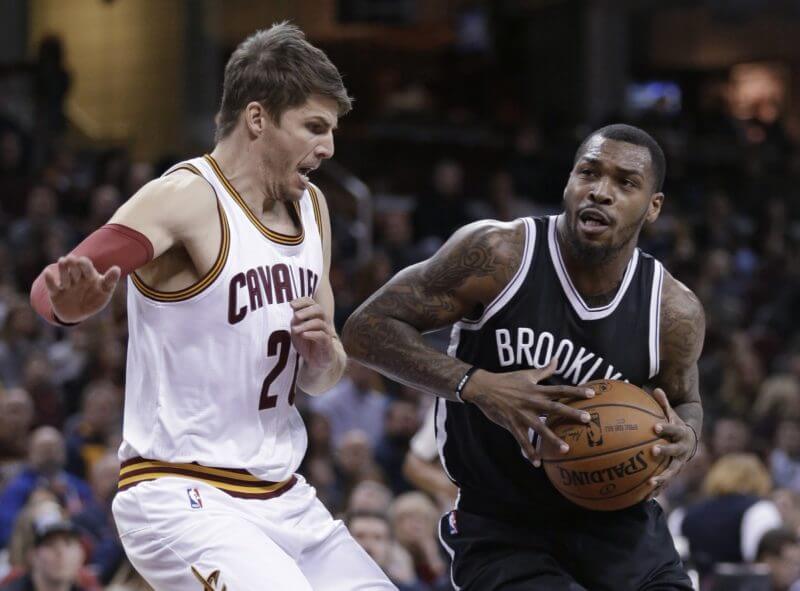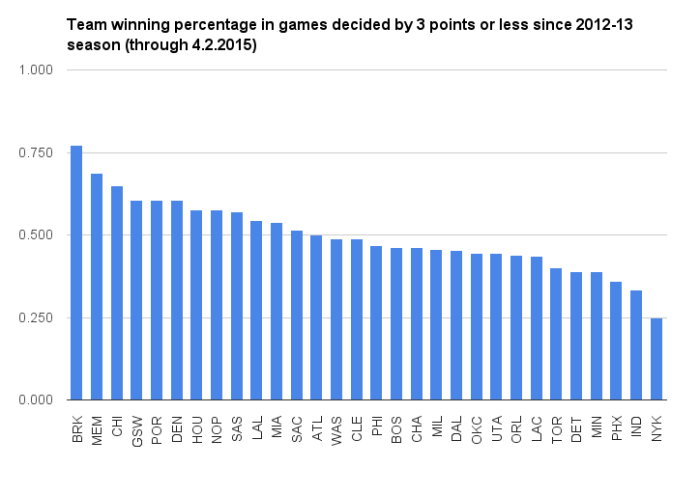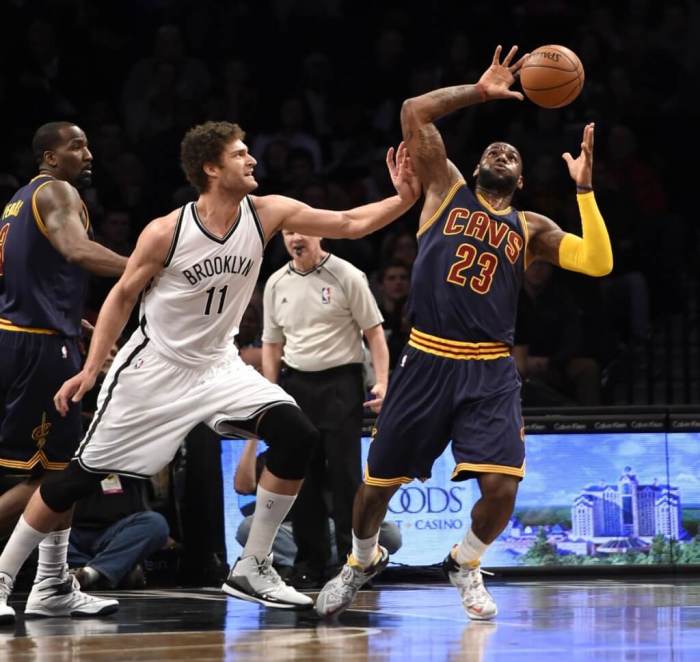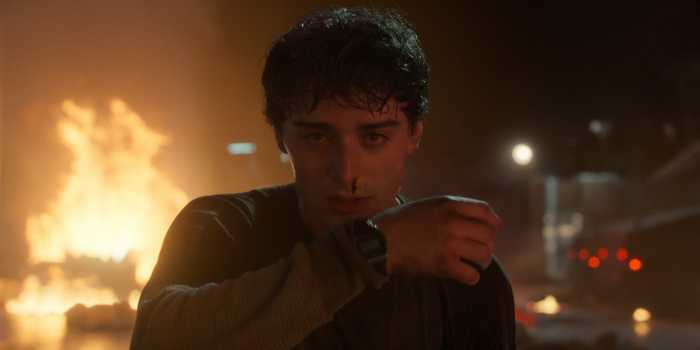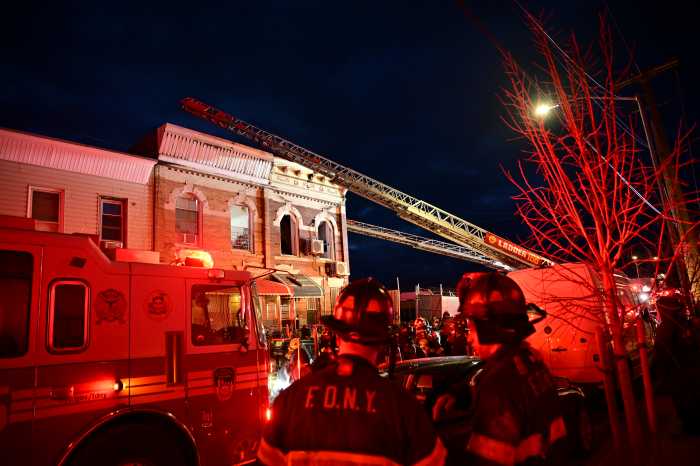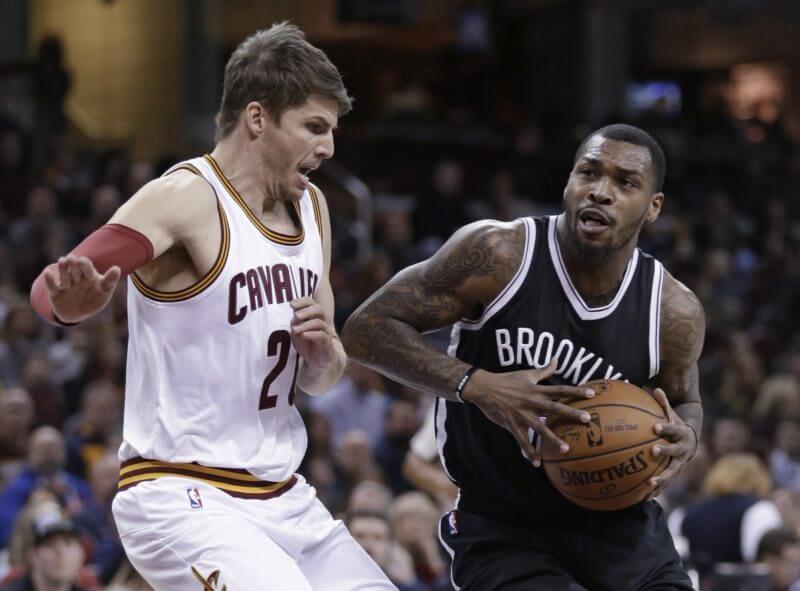
75 Cents on a Dollar: The Nets’ 4th Quarter Offense Issues in Detail
The Brooklyn Nets’ have lost games this season in every way possible. Some losses were soul crushing and other losses could be sensed after the first 5 minutes of the game. Even more Net losses were of the hey-that-wasn’t-that-bad variety. While they’ve typically struggled in the second half this season, those pesky #ThirdQuarterNets have officially moved for major ineptitude in the final twelve minutes each night. The Nets have shown #BrooklynGrit on the offensive end, competing in close games with top teams and looks far from being the worst team in the league through 36 minutes.
The Nets’ defensive deficiencies compound stagnant fourth quarter offense – 2-point games become 10-point deficits in the blink of an eye, with them struggling to even attempt a shot at times. This has happened all too often in Kenny Atkinson’s first season at the helm in Brooklyn. The NBA defines clutch situations as “possessions that occur with less than five minutes left in the fourth quarter, with neither team leading by five points.” Now, take a look at some Nets clutch stats…
Now, take a look at some Nets clutch stats:
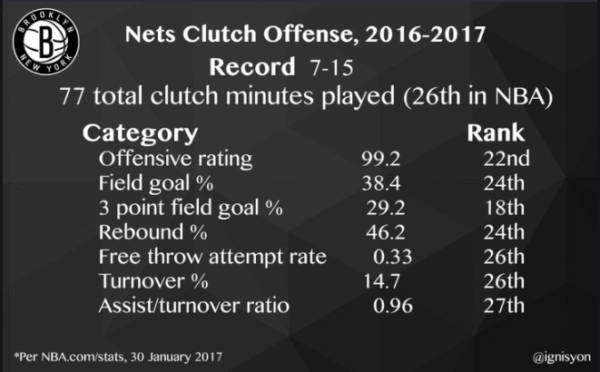
Many of these fourth quarter issues arise from poor decision-making. In my last piece, I implicated poor ball movement, inefficient passing, and frantic pace as being responsible for the woes that have led to Nets’ scoring droughts. In the fourth quarter, all these issues come to the forefront. Additionally, the Nets have a tendency to play outside of the offense in close games, crowning a new standard for league stagnation. Players are tasked to create with minimal ball movement, all while the rest of the team observes. What was a 5-on-5 game quickly devolves into a 1-on-1 or 1-on-everyone, not dissimilar to those woeful isolation years. This disrupts the rhythm of the other four Nets on the court and the flow of the offense as a whole — the shot clock drains and shots are forced. These issues may be the result of defensive adjustments.
But, at other times, the Nets’ fourth quarter struggles seem to be self-inflicted — let’s take a look at two of their recent giveaways:
Brooklyn Nets vs. Miami Heat
Final score: Heat 109, Nets 106
This is a game in which the Nets led by 18 points at the beginning of the fourth quarter. In this game, Caris LeVert claimed Wayne Ellington’s soul, Trevor Booker brought out the yams, and Brook Lopez made his case for an all 7-footer 3-point contest this All-Star Weekend. But that was through the first 36 minutes… and in the fourth quarter, the Nets entered Bizarro World (or Earth-2, if you like Golden Age DC Superheroes.)
These are consecutive possessions from the fourth quarter of last week’s Miami Heat matchup — of course, keep in mind the score in the lower right corner. On the first play, the Nets run Horns with Spencer Dinwiddie alongside Rondae Hollis-Jefferson and Lopez.
Lopez gets a clean look from three-point land on a pick-and-pop relatively early in the shot clock. The center misses, but it was a good look, especially with Lopez cooking from three early in the game. Before that, Lopez was 11-18 from the field, and 7-12 from three.
Coming out of a Strong set, both Bojan Bogdanovic and LeVert try to find Lopez in the paint. Lopez drew the foul on that play, but he had to work very hard against Willie Reed just to get the ball. The score after the Lopez free throws was 99-89. Not so bad, right? On the very next possession, this happened…
The Nets don’t run a specific set here and the only action comes off of a LeVert screen for Lopez. The screen may have come too far from the basket, with Lopez asking for the ball two steps inside the three-point line. Lopez tries to establish position, but Reed fights (again) to deny a clean entry pass. Dinwiddie dribbles it for 8 seconds, searching for the proper angle for Lopez. There is no movement off the ball, with wings LeVert, Hollis-Jefferson, and Randy Foye just watching. Lopez fires up a contested, long two-pointer with 6 seconds left on the shot clock.
At this point, I felt it coming and so did you, probably.
These were the next two offensive possessions:
Then followed up with this mess:
Notice a trend? This is not an indictment on Lopez at all — he played fantastically through the third quarter, taking and making three-pointers off of smooth ball movement and rhythm, while also mixing it up down low. He was the Nets’ best offensive player up until the collapse, make no mistake. But when the same player is given the ball five times in a row with no success, that’s basically asking Dion Waiters to rename the Barclays Center to “Waiters Island, NY.”
It ended up backfiring, but with creators and shot makers like Randy Foye, Hollis-Jefferson, LeVert, and Bogdanovic on the floor relegated to standing and watching, it can be frustrating to watch.
From 6:00 onwards, the Nets’ fortunes flipped completely. The team reverted to a pass-and-isolate style that yielded no success. It was reminiscent of the Brooklyn Nets of yesteryear — hi, Joe, Deron, and Jarrett.
Here are a few of the other Nets plays late in that fourth quarter, but don’t watch if you’re squeamish:
From those three, there was only one play with solid ball movement. In the first possession, the Nets run a pick-and-pop with Lopez and LeVert. They swung the ball and reloaded with Booker as the new roll man but Waiters (!) doubled LeVert on his move. The Heat played a good defensive possession there, with good reads on both screens.
So, what’s next?
Coming off of a timeout, Foye sets two flex screens, setting up both the entry pass player, LeVert, and the low post player, Lopez. Lionel Hollins used similar flex screen action with Deron Williams setting Lopez up quite frequently in 2014-2015. The second option for Dinwiddie was a Booker screen, but the lane was crowded. Lopez gets good position on the block off of the screen, but again, Reed denied the entry pass. LeVert makes a good read, seeing Lopez struggle down low, attacking instead of waiting for an angle. LeVert drew contact and a foul.
Not bad, but the Nets probably dipped into the Lopez fondue too much at that point in the game.
And, finally:
OK, OK! I’ll stop! At that point, the energy of the team (and pro-Nets crowd) just disappeared — it was disheartening. Ironically, the Nets built their lead in the third off of great ball movement, finding each other in the flow of the offense. The fourth quarter of that game was the exact opposite of that.
Brooklyn Nets vs Charlotte Hornets
Final score: Hornets 112, Nets 105
Sometimes, the Nets’ stagnant offense and fourth quarter droughts aren’t just due to feeding one player. The Nets suffered a game-changing drought late against the Charlotte Hornets and not one person was surprised. I may have elaborated on a few of these plays in my #woes piece, but it’s important to look at them in context. Like the Heat game, the Nets held the lead at points, but the game was much more back and forth…
The Nets lead by 1 at this point, with 6:44 left in the 4th. Here, Lopez gets the ball at the elbow extended for an iso and there is no movement off-ball. Ramon Sessions doubles Lopez with 10 seconds left on the shot clock, causing the Nets to swing the ball around the horn, ultimately finding Marvin Williams on Sean Kilpatrick. He makes his move but fumbles, retreating back to the perimeter as the shot clock dwindles. And, in the end, Kilpatrick doesn’t see Hollis-Jefferson in the paint, instead opting for a contested shot — which, nope.
In these two plays, the Nets run two of their primary sets, which is a welcome change in the fourth. In the first play, Dinwiddie initiates the Strong action — but rather than swinging it completely, Kilpatrick cuts off of one pin-down screen, receiving the handoff from Booker. The Hornets pack the paint on the drive and Kilpatrick floats a shot up, looking for a foul.
In the second play, Caris LeVert runs Horns. The Hornets’ interior defense defends well again on the drive, forcing LeVert into the air, thus telegraphing his spinning reset pass for a turnover.
Here, Booker unleashes Ultimate-Warrior-LeBron mode and scores with two larger defenders meeting him at the rim. That basket ended the team’s 3-minute scoring drought. But again, it seemed like the momentum had swung in favor of the opposing team. The Nets went on to see Nicolas Batum become a living embodiment of the flames emoji over the final few minutes. When the team can’t put up points during possessions or from the free throw line, it’s hard to regain a rhythm.
As we see in these clips, in both games, it can be a momentum killer on the offensive and defensive end of the court.
So what can the Nets do?
The fourth quarter issues are a manifestation of the Nets’ lack of big-game experience, an overlooked aspect in assessing the team’s performance. Only seven players on the team (Booker, Lin, Lopez, Bogdanovic, Booker, Scola, and Foye) have played significant playoff minutes, and only two — Luis Scola and Foye — have played over 20 playoff games in their careers. LeVert is the only current Net to play with an NCAA Final Four team. Only two players, Scola and Bogdanovic, have had big-time international experience, in the FIBA World Cup and the Olympics, respectively.
Along with a lack of high-pressure experience, several Nets lack in overall NBA experience. Replicating an NBA game is tough, but replicating the closing minutes of a tight game, where every possession matters, talent is world class, and coaching is top tier, is probably impossible. The Nets have learned this the hard way, throwing an inexperienced group of players into the fire.
Yes, the Nets stay close in games where they’re far overmatched, that’s not up for debate. Although the record may not show it, Kenny Atkinson, his staff, and the players show resiliency. Some may even call their effort…gritty. But yes, the team has struggled mightily, offensively and defensively. They often fail to execute in the fourth quarter. After striking out on system-fit players this season has been marked (pun intended) as a development year.
Development isn’t just about improving a jumper, putting on more muscle, or remembering that guac is extra. It’s also learning how to execute in close games and figuring out how successful programs play. The coach and team are under development, so, just take it easy on them for a little, would ya? They’ll get there in time and that’s the only thing this franchise has in spades.

